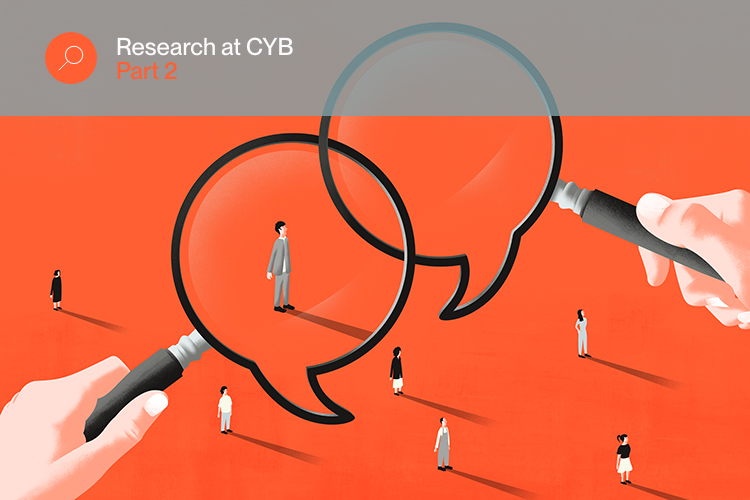
Research at CYB: Creating data validated user segments (part 2)
Last week, Caution Your Blast Ltd (CYB) began a blog series about a key area of our research - creating data validated user segments that can be used to make tailored hypotheses. Our associate Senior Performance Analyst John Drinkwater wrote about how data building capability lays the foundation for such work - you can read that here.
For Part 2, our Head of Research, Katie John, writes about creating data validated user segments, using our work on the Foreign, Commonwealth and Development Office’s (FCDO) Emergency Travel Document (ETD) service as a case study.
Creating data validated user segments
CYB’s work on the ETD service has been a huge undertaking, but a very successful one. With 40,000 British nationals stuck abroad applying for a single use travel document every year - that’s a lot of people who have lost their passport - it is one of the UK Government’s biggest services. Our task - to improve the application process for users - was therefore an important one.
So how did research help us achieve that goal - particularly the idea of creating data validated user segments?
Understanding our users
So exactly how has CYB helped improve the ETD process? The first thing we did was to make sure we fully understood who uses the service - and exactly how they use it. FCDO embassy staff help British nationals abroad in often very stressful circumstances - and having no passport and needing to get home certainly counts as an anxious situation - and see their role as providing reassurance and practical support to people in complex situations. But this close and individual-focussed approach in person is in strong contrast to the inflexible ‘one size fits all’ online service. This results in a plethora of work-arounds and parallel processes.
Although agents at both the ETD Centres and the FCDO Contact Centre often have a deep and detailed understanding of the range of applicant types and needs, service design has been carried out for a standard ‘applicant’ - who may or may not require an interview before issue. Without a shared framework through which the FCDO can understand the needs and experiences of different types of users, they have struggled to prioritise service improvements.
The current digital services were designed with a single applicant type in mind, so users experience the same service - whether they are a family on a two week holiday or a business person on a short stay trip. At best, this resulted in lots of unnecessary information, as users read content irrelevant to their situation (for instance, a young solo backpacker reading about how to apply on behalf of a child). At worst, conflicting guidance was confusing, potentially leading users abandoning the service altogether.
Our approach to enabling service improvement started with using primary user research and data analysis to understand the different contexts and needs that impact users when applying for an ETD. We considered key characteristics such as:
age
single or group travel
key reason for travel (e.g. returning home, making a short visit to another country, or continuing extended travel)
We then developed 5 user personas, through which we aimed to review user needs and experience.

Analysing data to identify patterns in user segments
Our next step was to look at the analytics data we collected from service systems. The aim was to validate the personas - testing what identifying data we could use to fit applicants into these segments, and to what degree service experience differed between them (in terms of application approval rate and elapsed time from application to approval).
In fact, we were able to identify more factors that differentiate user segments. One example was mode and complexity of travel plans: we found a strongly defined group of solo travellers who use one mode of transport for a one way or return journey (mostly flights), and another group of ‘Globe Trotters’ who take multiple modes of transport, making their applications more complex. We also identified a separate segment of applications from users who could not make payment with a debit or credit card (very few of which were completed). We could now confidently identify to which segment each application belongs.
From this analysis, we could see that the ‘Solo Traveller’ group (the most straightforward type of ETD application with the simplest set of information needs) makes up 60% of all applicants. We then thought - if we can identify these users during their application process, perhaps we could provide for them a simpler, clearer process?

Understanding the pain of our user segments
Our previous work with the FCDO was focussed on efficiency and the user need for fast access to ETDs. As part of this effort, we established a data analytics collection, transformation and visualisation service to track reasons for application rework and delay.
Now we were able to review all of this information by user segment to guide our understanding of the pain each group felt. It proved invaluable.
Our first insight? Solo Travellers were most likely to call the contact centre to chase or get an update on the status of their application.
Through further primary research we learned that solo travellers' primary motive for calling was to understand when they would have their ETD in their hands. Because these applications were the most straightforward to process, over 90% of these users were not contacted with any follow-up requests for information or documents – so during the stressful time awaiting approval, they heard nothing official.
The anxiety around not knowing when they would be able to fly home, or if they had to re-organise their travel plans, meant that users would pick up the phone to seek reassurance. This unmet need was something we prioritised to fix.
In the final blog post, we’ll share how we used these user segments to design tailored hypotheses that made for a much improved service. Watch out for that!